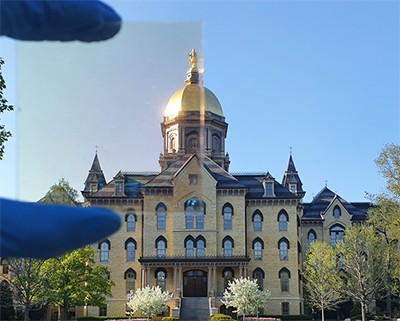Scientists have used advanced computing tech and AI to design a clear window coating that could lower the temperature inside buildings, thus saving a whole lot of cooling energy.
Cooling accounts for about 15% of global energy consumption, and it’s only going to get hotter, especially in more tropical climates.
The sun’s ultraviolet and near-infrared light are the parts of the solar spectrum that pass through window glass to heat an enclosed room.
If window coating blocked that light and if that coating radiated “heat from the window’s surface at a wavelength that passes through the atmosphere into outer space,” energy use from cooling could be reduced, according to the American Chemical Society.
That, along with not impeding visibility through a window, is kind of a big ask. But researchers at the University of Notre Dame in Indiana and Kyung Hee University in Seoul tackled it anyway.
According to their new paper, “High-Performance Transparent Radiative Cooler Designed by Quantum Computing” in ACS Energy Letters, a scientific journal published by the American Chemical Society, their design of a clear window coating, or “transparent radiative cooler” (TRC), was a success.

Here’s what they did and how it went:
The team constructed computer models of TRCs consisting of alternating thin layers of common materials like silicon dioxide, silicon nitride, aluminum oxide or titanium dioxide on a glass base, topped with a film of polydimethylsiloxane. They optimized the type, order, and combination of layers using an iterative approach guided by machine learning and quantum computing, which stores data using subatomic particles. This computing method carries out optimization faster and better than conventional computers because it can efficiently test all possible combinations in a fraction of a second. This produced a coating design that, when fabricated, beat the performance of conventionally designed TRCs in addition to one of the best commercial heat-reduction glasses on the market.

The researchers wrote that the average annual energy saving over surveyed US cities – see the bar graphs above – is 50 MJ/m2 if the TRC is used on windows. In cities with hot, dry weather, such as Phoenix, the TRC can potentially save around 86.3 MJ/m2 per year, or 31.1% of the cooling energy consumption when conventional windows are used.
They also did the same calculations for selected major cities worldwide. While buildings in all cities could benefit, those in tropical regions would get a greater cooling impact.
The researchers say that the clear window coating can be used not only on building windows but on car windows too.
There’s no indication of commercial scaling in the study, but the researchers write that the film “can be potentially scaled up for practical applications because their fabrication can be achieved using state-of-the-art deposition techniques.” In other words, that’s the process of creating and depositing thin film coatings onto a substrate material. It’s an important manufacturing step.
You can read the whole study here.
Read more: Windows giant Andersen leads $30M funding of solar window company
Photo: “Morning Glow ~ Explore #420” by Theen … is licensed under CC BY-NC-SA 2.0.
UnderstandSolar is a free service that links you to top-rated solar installers in your region for personalized solar estimates. Tesla now offers price matching, so it’s important to shop for the best quotes. Click here to learn more and get your quotes. — *ad.
Subscribe to Electrek on YouTube for exclusive videos and subscribe to the podcast.
